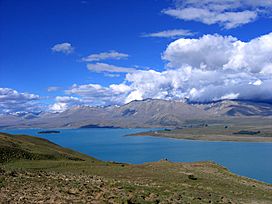Canterbury–Otago tussock grasslands facts for kids
Quick facts for kids Canterbury-Otago tussock grasslands |
|
|---|---|

Lake Tekapo, in the Mackenzie Basin, is a reservoir surrounded by tussock grassland
|
|
| Ecology | |
| Realm | Australasia |
| Biome | Temperate grasslands, savannas, and shrublands |
| Geography | |
| Area | 53,500 km2 (20,700 sq mi) |
| Country | New Zealand |
The Canterbury-Otago tussock grasslands are a special natural area in the South Island of New Zealand. This area is called an ecoregion because it has its own unique plants, animals, and climate. It's mostly covered in a type of grass called tussock.
Contents
Where are the Tussock Grasslands?
This large area of dry, grassy plains is found on the east side of New Zealand's South Island. It sits between the coast and the tall Southern Alps mountains. These mountains form the "backbone" of the South Island.
The grasslands are mainly in the Canterbury and Otago areas. They include the flat Canterbury Plains near the sea. There are also higher places like the mountains of Central Otago and the Hawkdun Range. You'll also find big flat basins, like the Mackenzie Basin and the Maniototo.
Climate and Rivers
This ecoregion is the largest flat plain in New Zealand. It's often used for grazing farm animals. The climate here is quite dry because the Southern Alps block most of the rain. Summers are warm, and winters are cold. The mountain basins are the driest spots, getting less than 500mm of rain each year.
Many rivers flow through the Canterbury Plains. Rivers like the Rangitata, Rakaia, and Waimakariri create a cool braided pattern. This means they split into many smaller streams that weave in and out. The rivers in Otago are deeper. New Zealand's largest river, the Clutha River, is found here.
Plants of the Grasslands
There aren't many plants that grow only in these grasslands. Long ago, there might have been forests here. But now, the plains are special because they are mostly covered in grasses. These grasses are tough and can handle dry weather and fires.
Types of Grasses and Shrubs
Many of the original tussock grasses, like slim snow tussock, have been replaced by grasses brought in by people. But some higher areas still have native Chionochloa tussocks. You can also find heath plants like Chionohebe and spiky Aciphylla.
Some rare plants live here too. These include the shrub Hebe cupressoides, a type of daisy called Olearia hectori, and some Peraxilla mistletoes.
Forest Patches
In a few spots, you can still see patches of native beech forest. The Hinewai Reserve on the Banks Peninsula protects some of these forests. They have trees like red beech and many evergreen shrubs. You might see kānuka, māhoe, Pseudopanax arboreus, Schefflera digitata, and kōwhai.
Taller conifer trees like tōtara, mataī, and kahikatea also grow here. The forest floor is home to many kinds of ferns.
River Plants
Near the rivers in Canterbury, you can find different plants. These include lichens, Raoulia daisies, willowherbs, and shrubs like Muehlenbeckia.
Animals of the Grasslands
The dry grasslands are home to many insects. You can find beetles, grasshoppers, cicadas, moths, and wētā. Wētā are a type of large grasshopper.
Special Insects and Lizards
One very special insect is the Prodontria lewisi. This beetle only lives in a small area of sand dunes near Cromwell.
Two rare lizards live here too: the Otago skink (Oligosoma otagense) and the grand skink (Oligosoma grande).
Riverbed Life
The riverbeds in Canterbury are important for small creatures without backbones. They are also vital for birds. The very rare black stilt (Himantopus novazelandiae) lives only in the wetlands of the Waitaki River system.
Another unique animal of the Canterbury plains is the Canterbury mudfish (Neochanna burrowsius). This fish can bury itself in the mud of riverbeds when they dry up.
Coastal Animals
The Otago Peninsula is a key breeding spot for two marine mammals. These are the New Zealand fur seal (Arctocephalus forsteri) and the New Zealand sea lion (Phocarctos hookeri).
Protecting the Grasslands
The tussock grasslands face several challenges. Most of the land is used for farming. Too much grazing by animals, more fires, and new buildings all cause harm. Waterways are also being changed.
Threats to Wildlife
Plants brought in from other countries also cause problems. These include lodgepole pine, broom, and sweet briar. Weeds like hawkweed can spread easily when land is overgrazed.
Animals brought in by people also cause damage. These Introduced species include possums, goats, red-necked wallaby, and red deer. Predators like cats, rats, stoats, and ferrets also harm native animals.
Conservation Efforts
Protecting the tussock grasslands is an ongoing effort. The Department of Conservation works with local communities. They are setting up protected areas and limiting grazing.
Some areas are already protected. These include the Rock and Pillar Range, Lammermoor Range, Old Man Range, Old Woman Range, Pisa Range, and The Remarkables. However, these are all in the higher areas. The original lowland habitats are in much worse shape and have almost disappeared. Special projects are also working to save the Canterbury lowland riverbeds and their endangered black stilt population.

